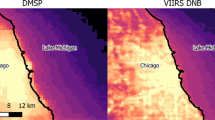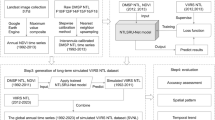Abstract
Nightsat is a concept for a satellite system capable of global observation of the location, form and density of lighted infrastructure and development within human settlements. Nightsat’s repeat cycle should be sufficient to produce an annual cloud-free composite of surface lighting to enable detection of growth rates. Airborne and satellite imagery have been used to define the range of spatial, spectral, and detection limit options for a future Nightsat mission. Our conclusion is that Nightsat should collect data from a near-synchronous orbit in the early evening with 50–100 m spatial resolution and have detection limits of 2.5E−8 W cm−2 sr−1 μm−1 or better. Multispectral low-light imaging data would be better than panchromatic data by providing valuable information on the type or character of lighting, a potentially stronger predictor of variables such as ambient population density and economic activity.




Similar content being viewed by others
References
Balk, D., Pozzi, F., Yetman, G., Deichmann, U., & Nelson, A. (2005). The distribution of people and the dimension of place: Methodologies to improve the global estimation of urban extent. Proceedings of the Urban Remote Sensing Conference, Tempe, Arizona, April 2005.
Cinzano, P., & Elvidge, C. D. (2004). Night sky brightness at sites from DMSP-OLS satellite measurements. Monthly Notices of the Royal Astronomical Society, 353, 1107–1116.
Cinzano, P., Falchi, F., Elvidge, C. D., & Baugh, K. E. (2000). The artificial night sky brightness mapped from DMSP operational linescan system measurements. Monthly Notices of the Royal Astronomical Society, 318, 641–657.
Cinzano, P., Falchi, F., & Elvidge, C. D. (2001a). Naked eye star visibility and limiting magnitude mapped from DMSP-OLS satellite data. Monthly Notices of the Royal Astronomical Society, 323, 34–46.
Cinzano, P., Falchi, F., & Elvidge, C. D. (2001b). The first world atlas of the artificial night sky brightness. Monthly Notices of the Royal Astronomical Society, 328, 689–707.
Dobson, J., Bright, E. A., Coleman, P. R., Durfee, R. C., & Worley, B. A. (2000). LandScan: A global population database for estimating populations at risk. Photogrammetric Engineering and Remote Sensing, 66, 849–857.
Doll, C. N. H., Muller, J.-P., & Elvidge, C. D. (2000). Night-time imagery as a tool for global mapping of socio-economic parameters and greenhouse gas emissions. Ambio, 29, 157–162.
Ebener, S., Murray, C., Tandon, A., & Elvidge, C. (2005). From wealth to health: modeling the distribution of income per capita at the sub-national level using nighttime lights imagery. International Journal of Health Geographics, 4, 5–14.
Elvidge, C. D., Baugh, K. E., Dietz, J. B., Bland, T., Sutton, P. C., & Kroehl, H. W. (1999). Radiance calibration of DMSP-OLS low-light imaging data of human settlements. Remote Sensing of Environment, 68, 77–88.
Elvidge, C. D., Baugh, K. E., Kihn, E. A., Kroehl, H. W., & Davis, E. R. (1997a). Mapping city lights with nighttime data from the DMSP Operational Linescan System. Photogrammetric Engineering and Remote Sensing, 63, 727–734.
Elvidge, C. D., Baugh, K. E., Hobson, V., Kihn, E., Kroehl, H., Davis, E., & Cocero, D. (1997b). Satellite inventory of human settlements using noctural radiation emissions: a contribution for the global toolchest. Global Change Biology, 3, 387–395.
Elvidge, C. D., Imhoff, M. L., Baugh, K. E., Hobson, V. R., Nelson, I., Safran, J., Dietz, J. B., & Tuttle, B. T. (2001). Night-time lights of the world: 1994–1995. ISPRS Journal of Photogrammetry & Remote Sensing, 56, 81–99.
Elvidge, C. D., Milesi, C., Dietz, J. B., Tuttle, B. T., Sutton, P. C., Nemani, R., & Vogelmann, J. E. (2004). U.S. constructed area approaches the size of Ohio. AGU Eos Transactions, 85, 233.
Global Rural–Urban Mapping Project, alpha version (GRUMP alpha), Centre for International Earth Science Information Network (CIESIN), Columbia University, International Food Policy Research Institute (IFPRI), The World Bank and Centro Internacional de Agricultura Tropical (CIAT). (2004). “Gridded population of the world, version 3, with urban reallocation (GPW–UR)”, Socioeconomic Data and Applications Centre (SEDAC), Columbia University, Palisades, NY, accessible at http://sedac.ciesin.columbia.edu/gpw (February 2006).
Imhoff, M. L., Bounoua, L., DeFries, R., Lawrence, W. T., Stutzer, D., Tucker, C. J., & Rickett, T. (2004). The consequences of urban land transformation on net primary productivity in the United States. Remote Sensing of Environment, 89, 434–443.
Imhoff, M. L., Lawrence, W. T., Elvidge, C. D., Paul, T., Levine, E., Privalsky, M. V., & Brown, V. (1997). Using nighttime DMSP/OLS images of city lights to estimate the impact of urban land use on soil resources in the United States. Remote Sensing of Environment, 59, 105–117.
Lee, T. F., Miller, S. D., Turk, F. J., Schueler, C., Julian, R., Deyo, S., Dills, P., & Wang, S. (2006). The NPOESS/VIIRS day/night visible sensor. Bulletin of the American Meteorological Society, 87(2), 191–199, doi: 10.1175/BAMS-87-2-191.
Milesi, C., Elvidge, C. D., Dietz, J. B., Tuttle, B. J., Nemani, R. R., & Running, S. W. (2005). Mapping and modeling the biogeochemical cycling of turf grasses in the United States. Environmental Management, 36, 426–438.
Milesi, C., Elvidge, C. D., Nemani, R. R., & Running, S. W. (2003). Assessing the impact of urban land development on net primary productivity in the southeastern United States. Remote Sensing of Environment, 86, 273–432.
Miller, S. D., Haddock, S. H. D., Elvidge, C. D., & Lee, T. F. (2005). Detection of a bioluminescent milky sea from space. Proceedings of the National Academy of Sciences, 102, 14181–14184.
Saxon, E. C., Parris, T., & Elvidge, C. D. (1997). Satellite surveillance of national CO2 emissions from fossil fuels. Harvard Institute for International Development, Development Discussion Paper 608.
Small, C. (2004). Global population distribution and urban land use in geophysical parameter space. Earth Interactions, 8, 1–18.
Small, C. (2005). Global analysis of urban reflectance. International Journal of Remote Sensing, 26, 661–681.
Small, C., & Cohen J. (2004). Continental physiography, climate and the global distribution of human population. Current Anthropology, 45, 269–277.
Small, C., Pozzi, F., & Elvidge, C. (2005). Spatial analysis of global urban extent from DMSP-OLS night lights. Remote Sensing of Environment, 96, 277–291.
Space Studies Board, National Research Council. (2007). Earth science and applications from space: National imperatives for the next decade and beyond (committee on earth science and applications from space: A community assessment and strategy for the future) ISBN: 0-309-66900-6, 400 p.
Sutton, P. (1997). Modeling population density with nighttime satellite imagery and GIS. Computers, Environment, and Urban Systems, 21, 227–244.
Sutton, P. C. (2003). A scale-adjusted measure of “urban sprawl” using nighttime satellite imagery. Remote Sensing of Environment, 86, 353–363.
Sutton, P. C., Roberts, D., Elvidge, C., & Baugh, K. (2001) Census from heaven: An estimate of the global population using nighttime satellite imagery. International Journal of Remote Sensing, 22, 3061–3076.
Sutton, P., Roberts, D., Elvidge, C. D., & Meij, J. (1997). A comparison of nighttime satellite imagery and population density for the continental United States. Photogrammetric Engineering and Remote Sensing, 63, 1303–1313.
Sutton, P. C., Elvidge, C., & Obremski, T. (2003) Building and evaluating models to estimate ambient population density. Photogrammetric Engineering and Remote Sensing, 69, 545–553.
Sutton, P. C., Ghosh, T., & Elvidge, C. D. (2007). Estimation of gross domestic product at sub-national scales using nighttime satellite imagery. International Journal of Ecological Economics & Statistics 8(S07) ISSN 0973–1385.
Toenges-schuller, N., Stein, O., Rohrer, F., Wahner, A., Richter, A., Burrows, J. P., Beirle, S., Wagner, T., Platt, U., & Elvidge C. D. (2006). Global distribution patter of anthropogenic nitrogen oxide emissions: Correlation analysis of satellite measurements and model calculations. Journal of Geophysical Research, 111, D05312.
Weeks, J. R. (2004). Using remote sensing and geographic information systems to identify the underlying properties of urban environments. In T. Champion & G. Hugo (Eds.), New forms of urbanization: Conceptualizing and measuring human settlement in the twenty-first century. London: Ashgate Publishing Limited.
Author information
Authors and Affiliations
Corresponding author
Rights and permissions
About this article
Cite this article
Elvidge, C.D., Safran, J., Tuttle, B. et al. Potential for global mapping of development via a nightsat mission. GeoJournal 69, 45–53 (2007). https://doi.org/10.1007/s10708-007-9104-x
Received:
Accepted:
Published:
Issue Date:
DOI: https://doi.org/10.1007/s10708-007-9104-x




